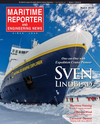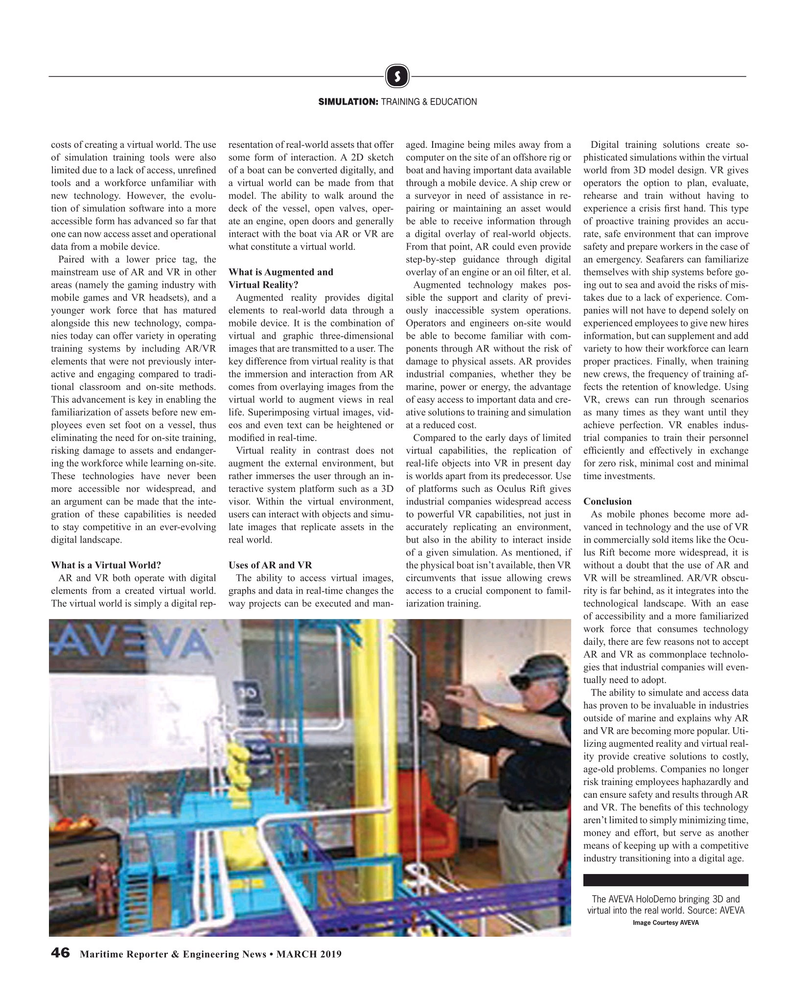
Page 46: of Maritime Reporter Magazine (March 2019)
Cruise Shipping
Read this page in Pdf, Flash or Html5 edition of March 2019 Maritime Reporter Magazine
S
SIMULATION: TRAINING & EDUCATION costs of creating a virtual world. The use resentation of real-world assets that offer aged. Imagine being miles away from a Digital training solutions create so- of simulation training tools were also some form of interaction. A 2D sketch computer on the site of an offshore rig or phisticated simulations within the virtual limited due to a lack of access, unre? ned of a boat can be converted digitally, and boat and having important data available world from 3D model design. VR gives tools and a workforce unfamiliar with a virtual world can be made from that through a mobile device. A ship crew or operators the option to plan, evaluate, new technology. However, the evolu- model. The ability to walk around the a surveyor in need of assistance in re- rehearse and train without having to tion of simulation software into a more deck of the vessel, open valves, oper- pairing or maintaining an asset would experience a crisis ? rst hand. This type accessible form has advanced so far that ate an engine, open doors and generally be able to receive information through of proactive training provides an accu- one can now access asset and operational interact with the boat via AR or VR are a digital overlay of real-world objects. rate, safe environment that can improve data from a mobile device. what constitute a virtual world. From that point, AR could even provide safety and prepare workers in the case of
Paired with a lower price tag, the step-by-step guidance through digital an emergency. Seafarers can familiarize mainstream use of AR and VR in other What is Augmented and overlay of an engine or an oil ? lter, et al. themselves with ship systems before go- areas (namely the gaming industry with Virtual Reality? Augmented technology makes pos- ing out to sea and avoid the risks of mis- mobile games and VR headsets), and a Augmented reality provides digital sible the support and clarity of previ- takes due to a lack of experience. Com- younger work force that has matured elements to real-world data through a ously inaccessible system operations. panies will not have to depend solely on alongside this new technology, compa- mobile device. It is the combination of Operators and engineers on-site would experienced employees to give new hires nies today can offer variety in operating virtual and graphic three-dimensional be able to become familiar with com- information, but can supplement and add training systems by including AR/VR images that are transmitted to a user. The ponents through AR without the risk of variety to how their workforce can learn elements that were not previously inter- key difference from virtual reality is that damage to physical assets. AR provides proper practices. Finally, when training active and engaging compared to tradi- the immersion and interaction from AR industrial companies, whether they be new crews, the frequency of training af- tional classroom and on-site methods. comes from overlaying images from the marine, power or energy, the advantage fects the retention of knowledge. Using
This advancement is key in enabling the virtual world to augment views in real of easy access to important data and cre- VR, crews can run through scenarios familiarization of assets before new em- life. Superimposing virtual images, vid- ative solutions to training and simulation as many times as they want until they ployees even set foot on a vessel, thus eos and even text can be heightened or at a reduced cost. achieve perfection. VR enables indus- eliminating the need for on-site training, modi? ed in real-time. Compared to the early days of limited trial companies to train their personnel risking damage to assets and endanger- Virtual reality in contrast does not virtual capabilities, the replication of ef? ciently and effectively in exchange ing the workforce while learning on-site. augment the external environment, but real-life objects into VR in present day for zero risk, minimal cost and minimal
These technologies have never been rather immerses the user through an in- is worlds apart from its predecessor. Use time investments.
more accessible nor widespread, and teractive system platform such as a 3D of platforms such as Oculus Rift gives an argument can be made that the inte- visor. Within the virtual environment, industrial companies widespread access Conclusion gration of these capabilities is needed users can interact with objects and simu- to powerful VR capabilities, not just in As mobile phones become more ad- to stay competitive in an ever-evolving late images that replicate assets in the accurately replicating an environment, vanced in technology and the use of VR digital landscape. real world. but also in the ability to interact inside in commercially sold items like the Ocu- of a given simulation. As mentioned, if lus Rift become more widespread, it is
What is a Virtual World? Uses of AR and VR the physical boat isn’t available, then VR without a doubt that the use of AR and
AR and VR both operate with digital The ability to access virtual images, circumvents that issue allowing crews VR will be streamlined. AR/VR obscu- elements from a created virtual world. graphs and data in real-time changes the access to a crucial component to famil- rity is far behind, as it integrates into the
The virtual world is simply a digital rep- way projects can be executed and man- iarization training. technological landscape. With an ease of accessibility and a more familiarized work force that consumes technology daily, there are few reasons not to accept
AR and VR as commonplace technolo- gies that industrial companies will even- tually need to adopt.
The ability to simulate and access data has proven to be invaluable in industries outside of marine and explains why AR and VR are becoming more popular. Uti- lizing augmented reality and virtual real- ity provide creative solutions to costly, age-old problems. Companies no longer risk training employees haphazardly and can ensure safety and results through AR and VR. The bene? ts of this technology aren’t limited to simply minimizing time, money and effort, but serve as another means of keeping up with a competitive industry transitioning into a digital age.
The AVEVA HoloDemo bringing 3D and virtual into the real world. Source: AVEVA
Image Courtesy AVEVA 46 Maritime Reporter & Engineering News • MARCH 2019
MR #3 (42-49).indd 46 3/7/2019 10:53:04 AM

 45
45

 47
47
